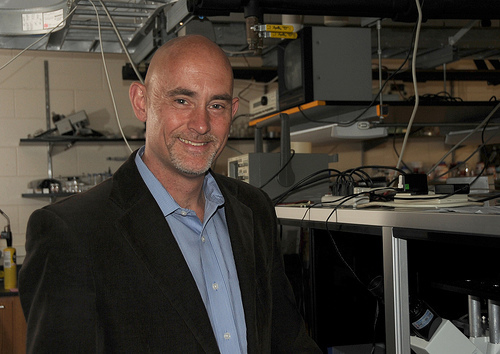Nearly every molecule studied in the field of chemistry contains characteristic vibrational “fingerprints” that are unique to the molecule. Infrared microscopes that probe these fingerprints are a mainstay in laboratories, but do not have sufficient sensitivity and resolution to detect individual nanoparticles or molecules – they can only be used study large collections of molecules.
Researchers at the University of Notre Dame recently developed an all-optical tabletop technique, called infrared photothermal heterodyne imaging (IR-PHI), that beats normal infrared microscopes by overcoming limitations caused by how tightly light can be focused.

In a recent paper published in the Proceedings of the National Academy of Sciences (PNAS), Gregory Hartland, Masaru Kuno, and Jon Camden, all professors in the Department of Chemistry and Biochemistry, and collaborators used IR-PHI to study single gold nanowires. Metal nanowires are part of a broader class of “plasmonic” materials that have potential uses in applications such as photovoltaics, chemical sensors and as substrates for surface enhanced spectroscopies.
“This is the first time this has ever been done with light,” Hartland said. “Professor Camden had previously shown how to do this with electrons, but that’s a different type of experiment.”
Conventional plasmonic materials used for applications like solar energy conversion have resonances in the near-infrared to visible portions of the light spectrum, but researchers have rarely explored other parts of the spectrum. In the PNAS paper the Notre Dame team used IR-PHI to “see” the mid-infrared plasmon resonances of individual gold nanowires.
The study illustrates how different plasmon resonances look within the nanowires, and how the frequencies change with the dimensions of the nanowires. The PNAS study also shows that plasmon resonances in the mid-IR have very long lifetimes – much longer than expected based on conventional theories.
Members of the Notre Dame team, which included Kyle Aleshire MS ’19, Ilia Pavlovetc, a fourth-year graduate student, and Shubin Zhang, also a fourth-year graduate student, say the results from this work are encouraging for finding new and unexpected properties of plasmonic materials. This discovery also opens the door to studying the infrared absorption of other types of nanostructures, and even individual molecules.
“Being able to identify a single nano-object or molecule through IR spectroscopy represents the ultimate detection limit in chemical analysis,” Hartland said.
Camden, Hartland, and Kuno are affiliated with ND Energy and NDnano. This research was supported by grants from the National Science Foundation and the U.S. Department of Energy, and was performed in conjunction with researchers from the University of Tennessee and the University of Washington.
Originally published by at science.nd.edu on March 24, 2020.